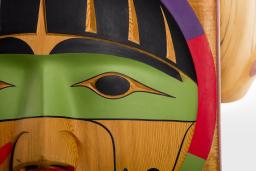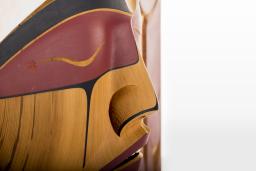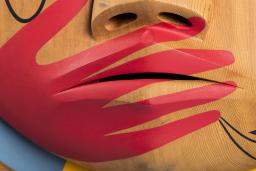This article series has focused on the way we present Indigenous content within the Museum and how we are approaching reconciliation.
Truth and reconciliation: What’s next?
By Karine Duhamel
Published: August 8, 2017
Tags:

Photo: CMHR, Aaron Cohen
Story text
Reconciliation, defined in previous blogs as a process based on hope, remains the core animating principle of a collection of stories that brings together the importance of Indigenous worldviews, the need to acknowledge violations as shared history, and the priority we place on empowering communities to share their stories. In the final blog in this series, I’d like to turn to what’s next – how the lessons we’ve learned along the way have inspired new adaptations of our practice. This process is, and will always be, ongoing in the sense that we constantly strive to work with this content to make it more meaningful and impactful for all visitors.
While 2017 marks the 150th anniversary of Canada’s Confederation, for many Indigenous people, this anniversary is nothing to celebrate. Instead, 2017 marks the 150th anniversary of an abusive colonial relationship, established prior to Canadian Confederation and continuing today. Would it be possible for the Museum to approach these stories of violation and advocacy in a meaningful way in 2017? Early on, curatorial staff decided on an approach which, like the Museum itself, would present human and Indigenous rights violations as shared history. To do this, we created several different spaces within our exhibitions and programs, some of which come from or are about Indigenous peoples, and others which are centred on policies applied by the Government of Canada to Indigenous peoples.
Not wanting to portray Indigenous peoples and nations as one‐dimensional or as victims, we considered different ways our upcoming exhibition, Rights of Passage: Canada at 150, could provide a space for stories that would articulate all of the different ways that Indigenous people have, over the last 150 years, asserted their inherent rights in the face of many and ongoing violations. The point here is to underscore the idea that, if Canadian society and Canadian legislators really want to know what people want, they ought to really listen.
In addition, we considered ways to prioritize Indigenous worldviews. One solution is to create an exclusive exhibition space and to engage in a series of oral histories, designed to ensure that individuals and communities can articulate their histories and their perspectives in their own terms. We are making plans to include clips from these oral histories in the exhibition itself.
As an Indigenous curator working on Rights of Passage, I decided that it was personally important for me that the stories be told by Indigenous people from the perspectives of their own lives and particular communities. To ensure that authenticity, I asked my interviewees to review their transcripts and to point out passages they found to be the most important. In addition, I reached out to them to ask which parts of their stories they wanted to share, as well as to offer to display any relevant items they might identify that might help to convey their points of view.
Overall, the process was challenging. Finding people who wanted to be a part of the exhibition was initially difficult, as we were asking individuals to help define an exhibition through their stories. David Serkoak was the first person to contribute. An Ahiarmiut Elder, David’s family was relocated, first from Ennadai Lake and then to four subsequent locations in the high Arctic by the Government of Canada, without any prior or informed consent. Over the course of nearly two full days, David shared his heartbreaking story, as well as the story of his return to Ennadai Lake, with a group of elders, in the mid‐1980s. Importantly, the project also provided David with the opportunity to discuss some of his current work to gain recognition for his community’s relocation.
Listening to him share the story of his people, of their hardship, and of unimaginable loss, I was humbled by the incredible gift the Museum was receiving and by the openness and generosity he demonstrated in sharing them. Listening to Elder Serkoak speak about his story has been one of the most formative learning experiences of my career, and I am so appreciative of the hard work and the willingness of our contributors to share.
What’s next at the Museum? We continue to move towards more meaningful engagement, focusing more on the process through which we produce content, research and exhibitions. We are building on the work completed to this point, and we hope that the stories we are able to build collaboratively with individuals and communities will be meaningful to them, as well as to the broader Canadian and international public visiting the Museum. As an institution, we need to continue to approach our work with humility, keeping in mind that reconciliation will always be an unfinished journey, and meaningful acts of reconciliation can only be achieved by working with those to whom are owed redress, reparation and reconciliation.
Rights of Passage: Canada at 150 opened in December 2017.
Dive Deeper
Why reconciliation? Why now?
By Karine Duhamel
Since the publication of the Truth and Reconciliation Commission of Canada’s final report in 2015, more and more Canadians seem focused on the idea of reconciliation.

Reconciliation: A movement of hope or a movement of guilt?
By Karine Duhamel
In Why reconciliation? Why now? I talked about the idea of reconciliation as an invitation to a new and shared future and as a pathway towards a good life, both for Indigenous people and for other Canadians.

The nuts and bolts of reconciliation
By Karine Duhamel
As a child, I often visited museums. I was lucky to be able to travel with my family, and to visit interpretive spaces across the country.

Suggested citation
Suggested citation : Karine Duhamel. “Truth and reconciliation: What’s next?.” Canadian Museum for Human Rights. Published August 8, 2017. https://humanrights.ca/story/truth-and-reconciliation-whats-next